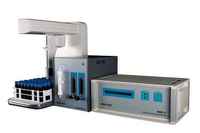|
Instrument Database:
Brooks Rand Labs - MERX Total Mercury Configuration for EPA 1631
| |
|

|
| |
|
| |
|
| Year of introduction |
2011 |
| Status |
available |
| Company |
Brooks Rand Labs
|
| Categories |
Dedicated Analyzer: Mercury
Spectrometer ( Atom. ): AFS
|
- Ultra-low level – instrument detection limit of <0.03 ng/L
- Wide linear range – quantifiable range of 5,000x (0.08-400 ng/L)
- Reduced contamination – The biggest challenge to performing quality ultra-low level mercury analysis is avoiding contamination. MERX greatly reduces sample contamination in two key areas:
- Carryover contamination – By purging samples in the vials, only gaseous elemental mercury is transferred from the vial through an inert transfer line to the amalgamation trap, vastly reducing carryover contamination. Most other systems struggle with carryover contamination due to the use of a common pump, transfer line and gas-liquid separator.
- Atmospheric contamination – Utilizing sealed sample containers on the autosampler prevents atmospheric mercury from contacting the sample. Other systems have open vials therefore requiring operation in a clean room type atmosphere.
- Reduced reagent consumption – Rather than requiring a continuous flow of reagents common to most other systems, MERX only uses the necessary amount of reagents to effectively reduce the sample, minimizing reagent and waste disposal costs.
- Less maintenance – In addition to syringe and peristaltic pumps being a huge source of cross contamination, these pumps generally require constant maintenance and tubing replacement. With the pump-free MERX system, these issues simply don’t exist.
TOTAL MERCURY METHODOLOGY
Sample Preparation Samples are prepared by standard total mercury methodology (U.S. EPA Method 1631) to oxidize all mercury to Hg(II).
Vial Loading Prepared samples are added to 40 mL vials with Teflon® lined septa caps. Samples are pre-reduced with the addition of hydroxylamine hydrochloride, and then reduced with stannous chloride, capped, and loaded into the autosampler.
Software Setup Sample information is entered into Mercury Guru™ software, settings are selected, and then sample analysis begins. MERX does the rest!
Purging Samples are purged directly in the autosampler vials using N2 gas to volatilize elemental mercury to the gold amalgamation traps.
Multi-Trap Processing The first collection trap is ballistically heated to release and transfer the mercury to the analytical trap, which is in turn heated to release the mercury to the detector. Simultaneously, the second vial is purged onto the other collection trap to provide near continuous sample purging for rapid throughput.
CVAFS Detection Mercury is detected using the Brooks Rand Model III cold vapor atomic fluorescence spectrophotometer (CVAFS) with patented optics for enhanced sensitivity.
Data Processing Mercury Guru™ software integrates the detector signal and calculates results based on calibration and sample volume information. QC results are automatically flagged based on user defined criteria.
|
|